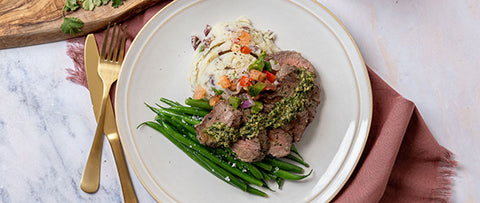Don’t get me started on flavor profiles! I love flavorful food, and a balanced profile takes any meal to the next level. Last night I was at a Mexican Cantina enjoying a piece of grilled Mahi Mahi over a bed of Spanish rice and yellow tomato puree. On top of the fish was citrus salsa and micro-greens. Fancy!
This dish was poppin’ with flavors from the balance of ingredients, spices, and sauces--creamy tomato puree, bright citrus salsa, aromatic cilantro marinade, flakey grilled fish, spicy Spanish rice. I think we all can agree this is why we go out to eat and don’t cook at home. We like food that tastes good and leave the hard work to the chefs.
Or, is this something we can experience in our homes and with our skills? Let me explain what a flavor profile is and walk you through how you CAN make a chef inspired dish at home!
Elements of a Flavor Profile
What is a flavor profile? A flavor profile is the combination of flavors and elements used in a dish. It’s basically when the witch throws all the ingredients together in the cauldron, stirs them up and then the magic happens, figuratively speaking.
Our tongues can taste and feel different flavors. Some primary elements with examples are:
- Sour - lemon juice, lime juice, orange juice, vinegar (red wine, balsamic, apple cider), tomatoes, pickled vegetables
- Sweet - carrots, sweet potatoes, corn, butternut squash, sugar snap peas, fennel, most fruit, parsnips
- Salty - kosher salt, sea salt, fish sauce, soy sauce, seaweed, hard cheeses like parmesan
- Spicy - hot sauce, wasabi, horseradish, dijon mustard, harissa, jalepenos, habaneros, arugula, raw radishes, watercress
- Unami - (the savoriness of the dish, ingredients that taste meaty or earthy) mushrooms, bacon, meats, beans
- Bitter - coffee, cacao, grapefruit juice, endives, broccoli, spinach, kale, radicchio
- Texture - creamy, flaky, silky, crunchy, crispy, juicy, hard, soft, crumbly, greasy, gooey, moist, mushy
- Temperature - hot, ice cold, cool, room temp, warm
One other thing I must hit on for flavor profiles are aromatics. Aromatics are aromatic vegetables, herbs and sometimes meats that are often cooked in some kind of fat (oil, butter, coconut milk, etc) to help release the flavors and create a flavor base for the dish. Examples of common aromatics are onion, garlic, thyme, parsley, cilantro, bay leaves and scallions.
Cuisine Examples
Here are a few examples of flavor profiles common in different cuisines:
- Asian - garlic, ginger, soy sauce, sesame oil, rice vinegar, sriracha
- Mexican - cumin, chili powder, onion, garlic, cilantro, lime, avocado, tomato, peppers, corn, black beans, cheese
- Thai - garlic, coriander, turmeric, lemongrass, basil, coconut milk, fish sauce, lime, peanut
- Indian - turmeric, cinnamon, cumin, nutmeg, curry, ginger, garlic, coconut milk, lentils, chick peas, onion
- Italian - garlic, basil, oregano, parsley, rosemary, thyme, parmesan, tomatoes, olives, lemon, mushrooms
- Mediterranean - basil, parsley, rosemary, dill, oregano, mint, lemon, cucumber, chickpeas, cilantro
Creating a Balanced Flavor Profile in a Dish
Certain elements will react with others and make the experience enjoyable. For example, adding salt to a baked item makes it more sweet. If your salad dressing is too sour, add some sweetness to mellow it out. These are examples of how combining ingredients can balance or enhance different flavors.
When creating a dish:
- Choose your cuisine.
- Choose a protein, carb, and veggie
- Layer different flavor elements
Since I’m feelin’ spicy 💃, let’s stick with the Mexican cuisine and semi re-create the dish I had last night. This Mexican dish has fish, rice, and tomatoes.
For the fish, lightly season, sear in a pan on one side, top with pesto, then finish in the oven. For the pesto, I would use a food processor to combine:
- Cilantro - Aromatic
- Jalapeno - Spicy
- Walnuts - Unami
- Lime - Sour
- Salt & Pepper - Salty
- Olive oil - Base
On top of the fish after it’s finished in the oven, we’ll add a citrus salsa:
- Grapefruit - Bitter
- Oranges - Sour
- Jicama - Crunchy
- Avocado - Creamy
- Avocado oil - Base
- Cilantro - Aromatic
- Honey - Sweet
- Lime - Sour
For the basmati rice, let’s make it a pilaf (a pilaf is simply a grain cooked with veggies and sometimes stock or broth). Sauté veggies and aromatics, pour in rice and water in a pot and steam.
- Basmati rice - Base
- Bell peppers - Sweet
- Onion - Aromatic
- Garlic - Aromatic
- Pumpkin seeds - Crunchy (finish with seeds after cooked)
- Green onion - Aromatic (finish with garnish after cooked)
As for our tomatoes, this is a much more complicated process. The tomatoes would need to have their skins removed, cooked down and strained of all seeds to get the smooth sauce I experienced with my dish. You can’t get a yellow tomato sauce from a can, and this is what gives this dish a summer feel. It’s so much lighter than a red sauce. For realistic purposes, I’m going to skip this one and suggest you roast tomatoes; it will save you hours. I would choose yellow heirloom tomatoes with olive oil, salt and pepper to finish the dish.
You’ll notice that I don’t have specific ratios here. If you like spicy, add more jalapeño. If you’re not a fan of garlic, use less. This is the fun part of cooking, you get to make it your own!
All of these components work nice with Mexican cuisine--cilantro, jicama, pumpkin seeds, lime, jalapeño just to name a few. It was a lot of fun to create this for you to see on paper. Let me reiterate that each element included in this dish helps to create a well rounded, complex flavor profile for each component within the dish and the dish as a whole. That is why this meal was mind blowing!
When we create fit-flavors meals, Chef and I always challenge ourselves to bring the profiles alive. It's fun and interesting to cook like this. I encourage you to create just one profile the next time you prepare a dish. Combine that with quality ingredients and portion control, and you’re on your way to a healthy lifestyle full of good eats. When you're short on time, fit-flavors is here to help.






